On the counter of Marshall’s Pasties in Grass Valley, next to a few of the awards the 53-year-old shop has accumulated, there’s a blackened metal lunch pail. It doesn’t look like much against the stacks of plaques and framed certificates, but the pail is a direct connection to the mines that once powered this gold rush town.
Marshall’s Pasties has an antique miner’s lunch pail on display.
(Photo courtesy of Marshall’s Pasties)
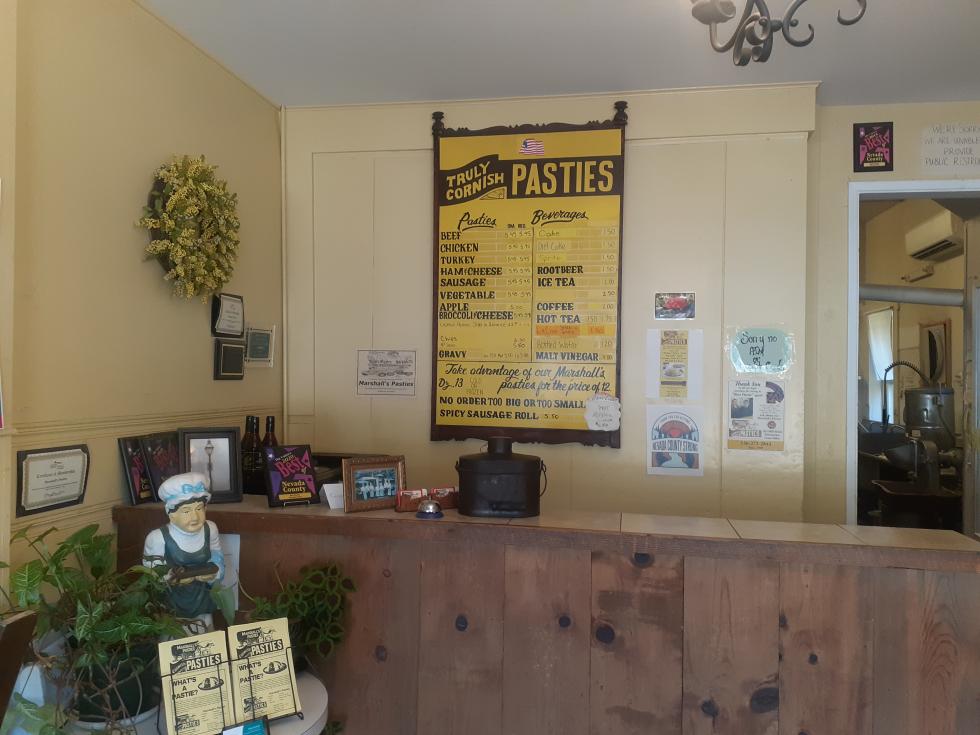
Before it retired sometime in the early 20th century, the two-tiered pail would have carried a miner’s midday meal into his subterranean workplace. Tea or coffee went in the bottom tier, and the top held a pasty: a handheld pie, usually filled with meat and potatoes, sealed under a crimped pastry crust. Miners would hang their pail above a candle to heat the tea or coffee, which would then steam the pasty.
No need for that at Marshall’s; its pasties are always served hot. Hundreds emerge from the oven in the back each morning, burnished pale gold. In cross section, they are geologic, apropos of their mining origins: Thin-sliced potatoes align like sedimentary layers, interspersed with bands of meat or vegetables. The shop goes through up to 80 pounds of potatoes a day, according to owner Carrie Locks.
“I pretty much make pasties 10, 11 hours a day,” says Locks, one of the six children of founder Marie Marshall. Locks has been working in the shop since it opened in 1968, when she was 15 years old, and took over after her mother’s death in 2005. She says her mother learned the art of pasty-making from the Cornish American women whose husbands worked alongside her own, a geologist, at the Sixteen to One Mine in Alleghany.
Beef and ham-and-cheese pasties are among the options at
Marshall’s Pasties in Grass Valley. (Photo by Steve Martarano)
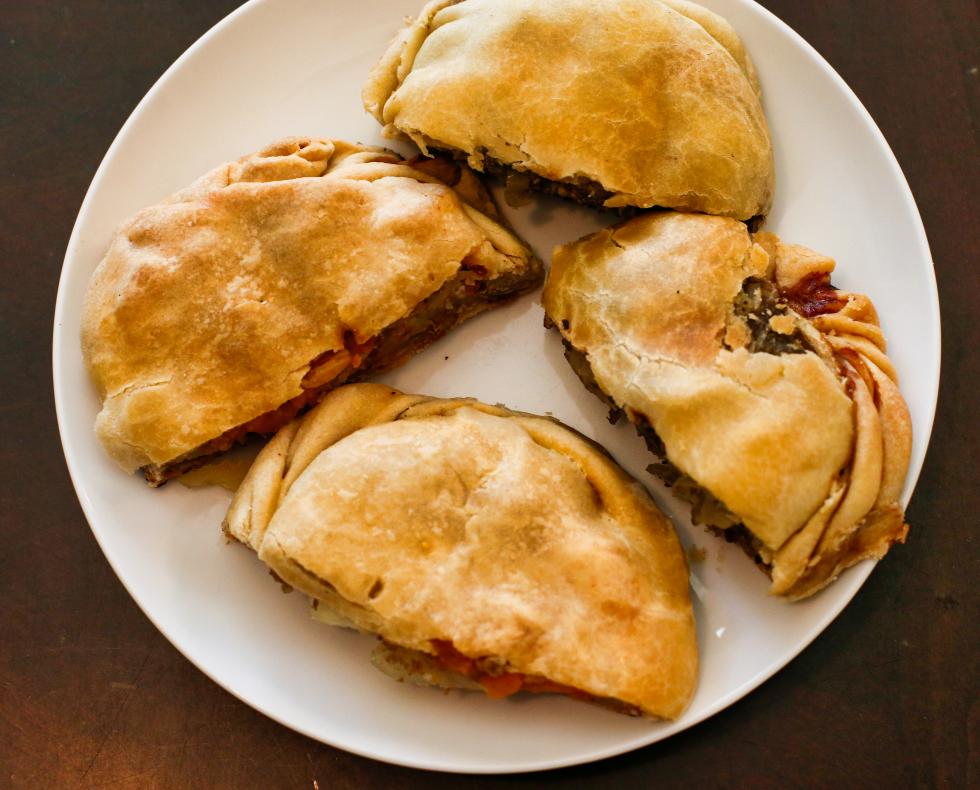
In previous generations, the ancestors and relatives of those Cornish men and women — then nicknamed Cousin Jacks and Cousin Jennies — would have descended into the gold mines of the Sierra Nevada, the silver mines of Mexico and other mineral regions around the world. Pasties are an edible trace of their presence, connecting Grass Valley to a global history of migration and extraction.
Related — A Tarnished Past: How stakeholders in the Sierra Nevada are confronting the lasting legacy of the gold rush
The Traveling Pasty
Pasties are the quintessential food of Cornwall, a region in southwest England that has mined tin and other metals since the Bronze Age. Though eaten by people of all classes and professions, pasties may have been especially useful in mines: A folk history suggests that miners avoided consuming the arsenic-laced dirt on their hands by holding on to the the crust and tossing it into the tunnels when they had finished the rest. (However, a Cornish cookbook published in 1929 argues that the “true Cornish way” to have a pasty is to start at one end and eat all the way to the other.)
By the 19th century, waning deposits and competition from other parts of the world cut into the profits of Cornwall’s mines, leading many of its residents to seek employment elsewhere. They gravitated toward freshly exploited mineral regions that valued the Cornish’s mining experience, including Australia, Mexico, South Africa, the Upper Peninsula of Michigan and, after 1849, the California Sierra Nevada. Grass Valley had an especially dense Cornish population — up to 85 percent in 1890 — due to the nearby Empire Mine, which depended on Cornish labor.
The building that houses Marshall’s Pasties was built in 1896 as
a hotel for single miners. (Photo by Steve Martarano)
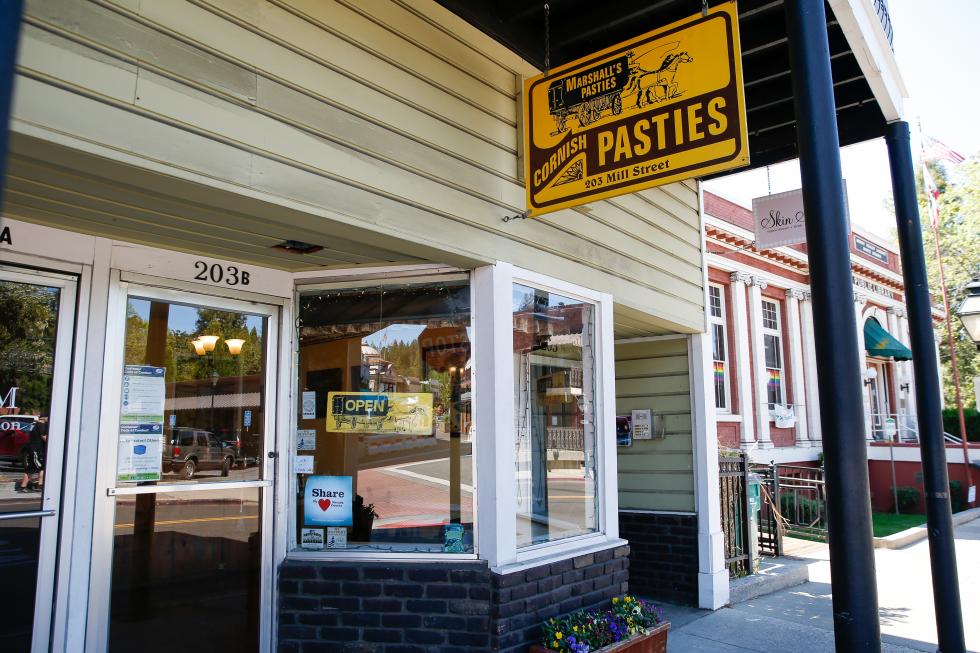
Pasties still play a role in the cuisines of all of the regions where Cornish miners settled in large numbers, though often adapted to local tastes. In Hidalgo, Mexico, for example, they are called pastes and may be stuffed with black beans in chipotle sauce or chicken mole instead of the usual beef and potatoes. In Grass Valley, they’ve evolved to meet Northern California preferences. Marshall’s offers two savory vegetarian options, while the gluten-free Corvus Bakery serves pasties that are both meatless and wheatless. The craft brewery Grass Valley Brewing Co. braises the beef for its pasties in its own stout, and BriarPatch Food Co-op makes its with organic produce.
No one is carrying these pasties into the mine tunnels — the Empire Mine closed in 1956, and the Sixteen to One ceased operations in 1965 (though small-scale mining continues at the site today) — but they’ve remained an everyday food. They are baked in abundance for St. Piran’s Day, the national day of Cornwall (March 5) and an annual celebration of Cornish heritage in Grass Valley, and for St. Patrick’s Day, when the co-op dyes its green with spinach juice. Schools and churches sell them for fundraisers, and parents pick them up when they’re too busy to cook dinner.
“Here in Grass Valley, pasties became sort of the essential food,” says Gage McKinney, an author and scholar who teaches Cornish history and culture for the Osher Lifelong Learning Institute at Sierra College in Grass Valley. “The Cornish brought them and made them and ate them and took them to work, but then everybody made pasties and ate pasties. Pasties kind of became the food that everybody knew and shared.”
They remain especially relevant for the descendants of the Cornish immigrants who once made up the majority of the town’s population. McKinney, who is among those descendants, speaks of pasties as a kind of holy sacrament specific to the Cornish diaspora. “You get into this area that I call the sacramental pasty,” he says. “You bake these pasties, and you’re sort of breaking crust with your ancestors. … There’s some sort of platonic standard, you know, the ideal pasty in the heavens or something, and people are always trying to live up to it.”
The Tradition Continues
Over the years, several Grass Valley businesses have tried to market the platonic pasty. There’s no record of a pasty shop in town before the 20th century, perhaps because many families made them at home. But after the last mines closed in the 1960s, Grass Valley began to capitalize on its mining history instead of its minerals.
At one point, there were four competing pasty shops within the small downtown. Two, Marshall’s Pasties and King Richard’s Pasties, opened in the 1960s, and another two, Mrs. Dubblebee’s and Cousin Jack Pasties, came along in the 1980s. The shops began dropping away in the late 1990s, leaving Marshall’s as the last bastion on the pasty front after Cousin Jack closed in 2018. With each closing, rumors would circulate that pasties were dying out in Grass Valley, soon to be replaced with more run-of-the-mill fast food.
Grass Valley native Jesse Hopper, right, owns Grass Valley Pasty
Co. with his friend from Sacramento, Tyler Rickards. (Photo
courtesy of Grass Valley Pasty Co.)
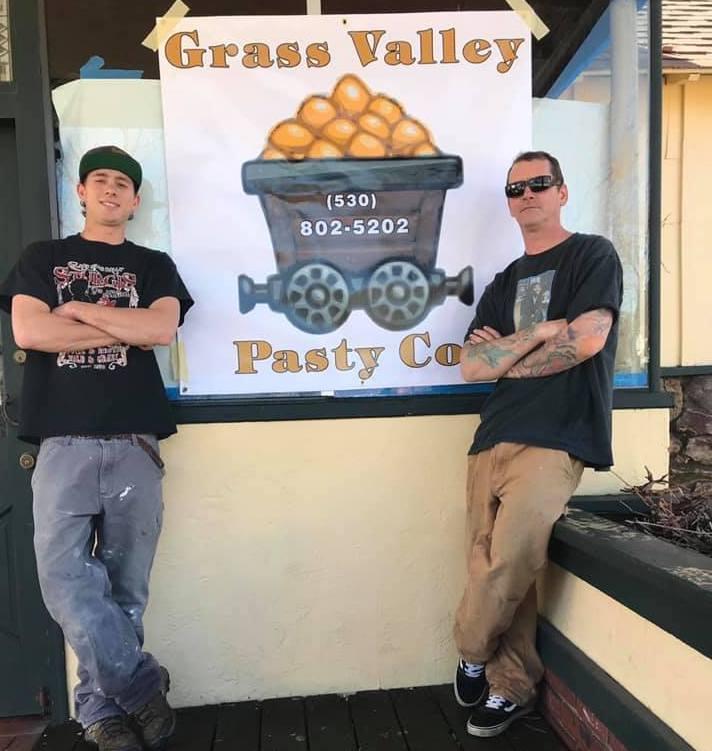
When Hopper and Rickards announced that they wanted to resurrect Cousin Jack, the town showed support. Hopper’s friends in the construction industry helped renovate, and the landlord put a hold on their rent until they could start selling. In June 2019, Grass Valley Pasty Co. held its much-anticipated grand opening. “I just didn’t want to see a monument disappear, and that’s what would happen if I wouldn’t have restarted this,” Hopper says. “It would have become another burrito place or something.”
Though the business is just short of its second birthday, it seems older. Other than clearing away the previous owner’s lace curtains and midcentury tchotchkes, the new owners have made few changes to the interior. They work behind the granite counter in an open kitchen dusted with flour, a utilitarian space with the well-worn feeling of a village bakery.
Grass Valley Pasty Co. owner Jesse Hopper estimates that he has
made 30,000 pasties since the shop opened. (Photo courtesy of
Grass Valley Pasty Co.)
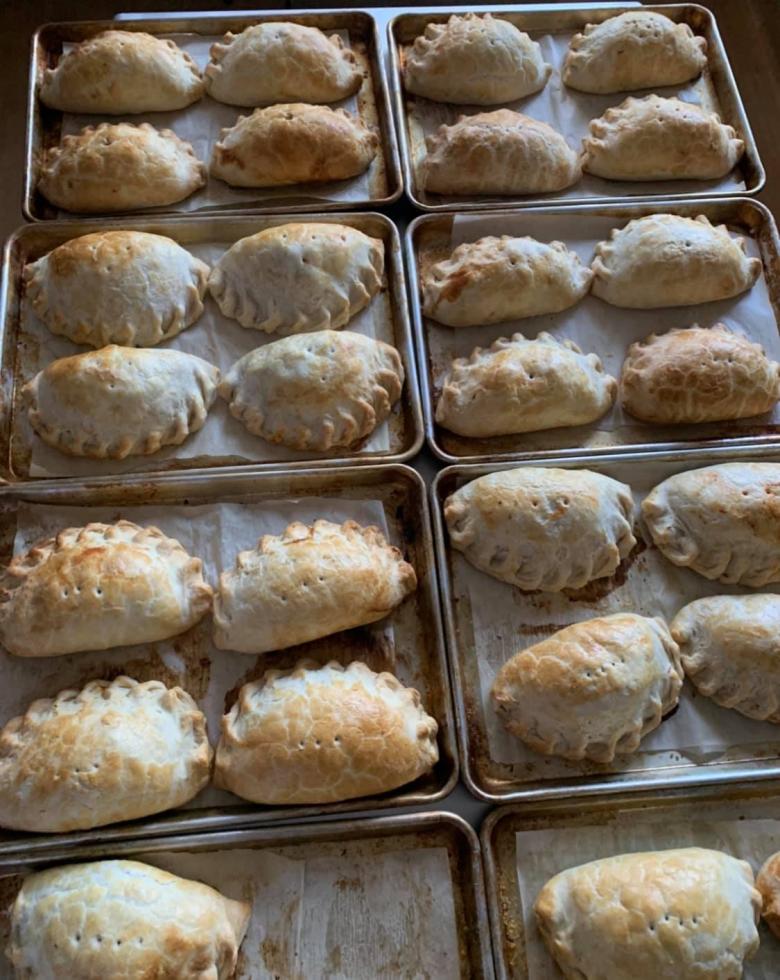
If there’s a rivalry between the last two pasty shops in Grass Valley, it’s a friendly one. McKinney says residents tend to patronize both businesses, and he’s glad for the freedom of choice. “They both do a great job, and their products are distinct from one another, but both of their products are a very good representation,” he says.
Both shops also make an effort to represent Grass Valley’s mining history. Marshall’s has its lunch pail, and Grass Valley Pasty Co. has a scale replica of an ore cart in the parking lot, drafted into a less extractive purpose as a flower planter.
“Our mine” — the Empire Mine, once the centerpiece of the most productive gold district in California — “is very important, you know,” says Locks, when asked why she and other Grass Valley businesses still cling to the imagery and mythos of a bygone age. “It’s our history, it’s our community. … I don’t think that will ever change.”
–
Stay up to date on business in the Capital Region: Subscribe to the Comstock’s newsletter today.
Recommended For You

A Tarnished Past
How stakeholders in the Sierra Nevada are confronting the lasting legacy of the gold rush
Over the past two decades, a coordinated effort focused on science and policy, education and awareness, and an entrepreneurial approach to workforce development has been underway to come to grips with the lasting legacy of the mining age.

Fighting for Recognition
Nevada City Rancheria spokesperson Shelly Covert on recovering land and federal status for the Nisenan Tribe
Comstock’s spoke to Covert — who was born and raised in Grass Valley — about her work with the Nisenan Tribe and why it matters.
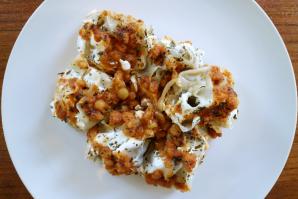
Neighborhood Favorite: Aria Afghan Restaurant
A former translator brings Central Asian flavors to North Highlands
Aria Afghan Restaurant in North Highlands serves a cuisine that
hails from the crossroads of South and Central Asia,
including one dish that takes over 10 hours to make.
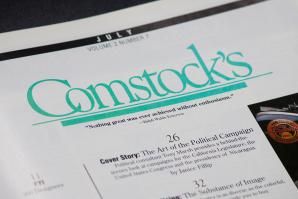
The Comstock Name Has a Long and Storied History
The July issue of our magazine has a very recognizable name across its masthead. Launching and publishing a magazine is not an easy quest, so I smile as I think that 30 years have passed. This month’s issue is the 360th edition of Comstock’s.



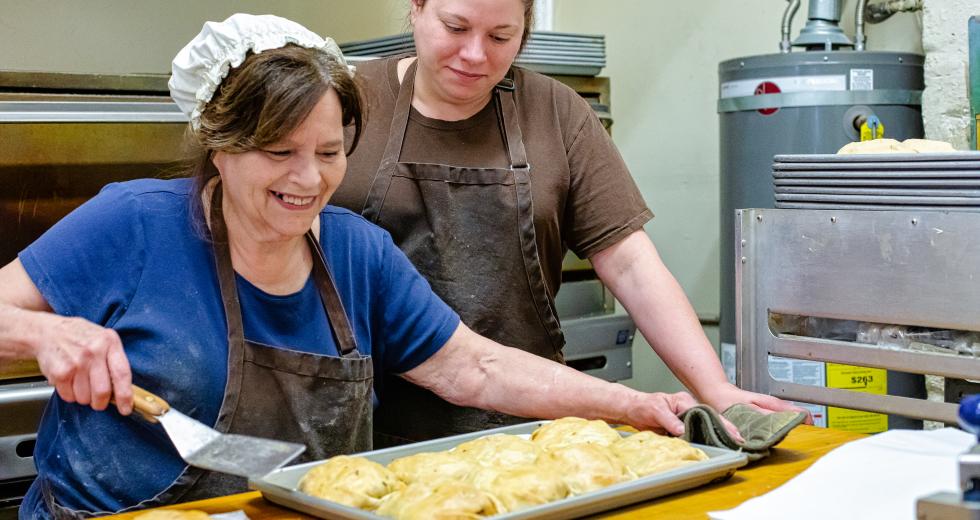
Comments
Thanks. An enjoyable article about a food I love to eat. Any vegan ones out there?
Interesting article, I have recently started a small pasties business here on the east coast in a little town called Tatamy Pennsylvania. I would love to share pasties stories!
75 years old, Born in Nevada City as were my parents and grandparents. Pasties were a family tradition. I served in the Navy for 28 years and traveled the world. Ate pasties in southern England as well as in Australia. Pasties always made me think of grandma's kitchen. Grandma lived in Nevada City in the Victorian at the corner of Cottage and North Pine from the mid 50s to the mid 70s.